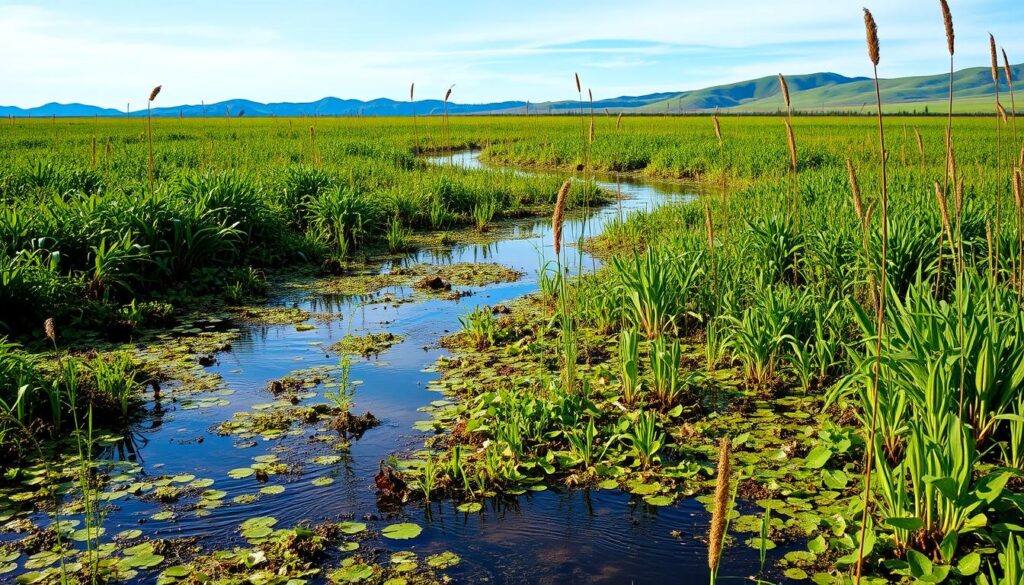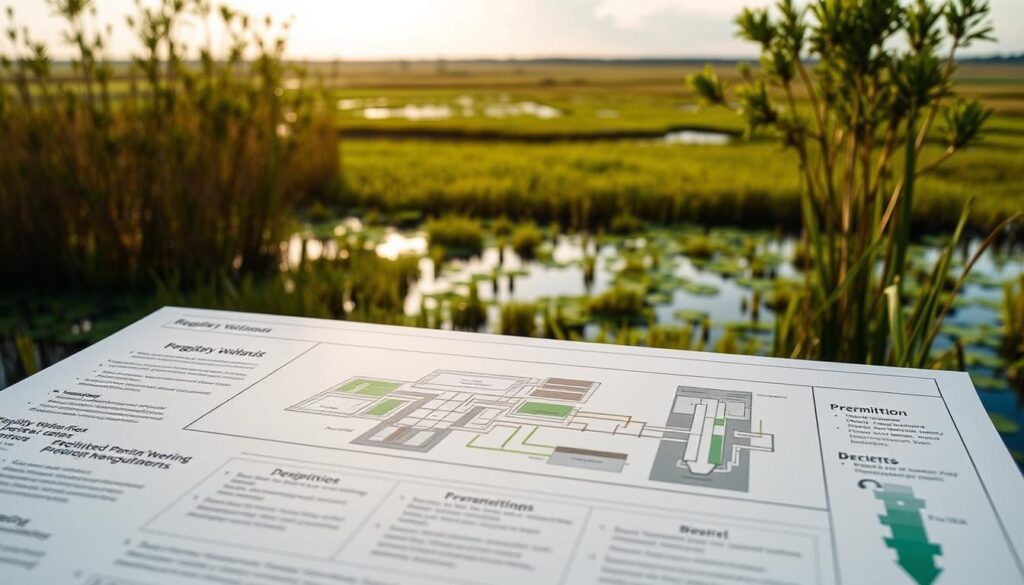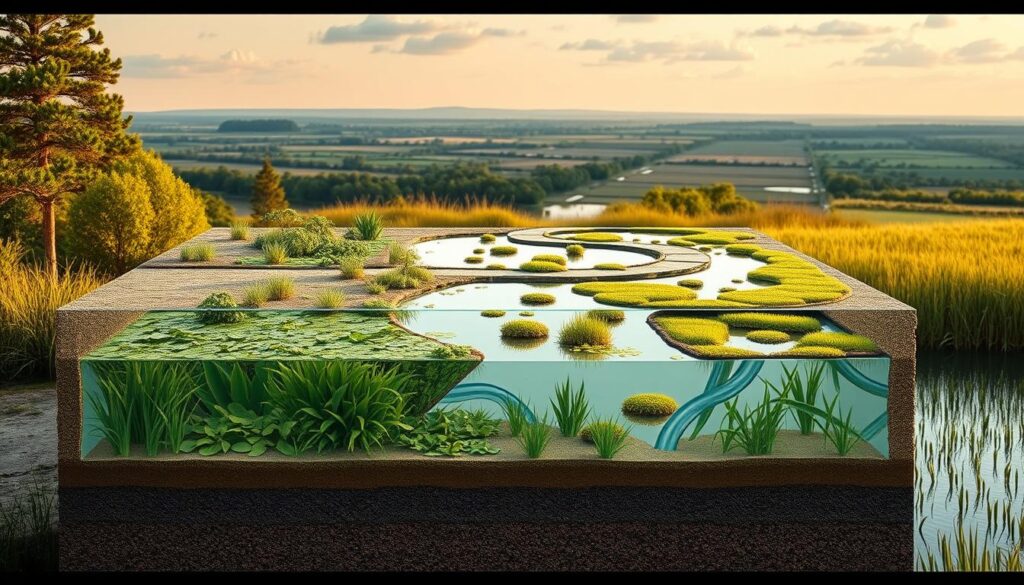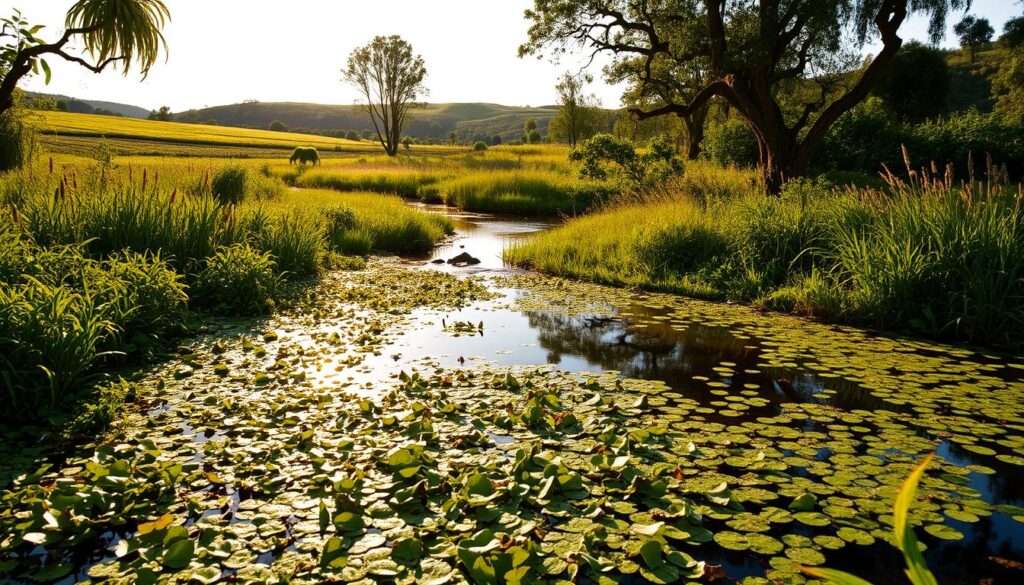Can natural processes be harnessed to improve water quality effectively? The answer lies in wetland design, a crucial aspect of sustainable water management. Constructed wetlands are engineered systems that utilize natural processes to treat wastewater and improve water quality, as noted by the EPA (EPA/625/1-88/022).
These systems play a vital role in maintaining ecological balance while addressing water pollution. Effective design is key to their success, incorporating principles that maximize their treatment capabilities.
Key Takeaways
- Understanding the role of constructed wetlands in water treatment.
- Importance of sustainable water management practices.
- Engineering essentials for effective wetland design.
- Natural processes utilized in constructed wetlands.
- Role of wetland design in improving water quality.
Introduction to Constructed Wetlands Engineering
Constructed wetlands engineering is an innovative approach to addressing environmental challenges through sustainable practices. This field combines engineering principles with ecological knowledge to create systems that can treat wastewater, manage stormwater, and provide habitats for wildlife.
Definition and Purpose
Constructed wetlands are man-made systems designed to mimic the functions of natural wetlands. They are engineered to treat various types of wastewater, including municipal, agricultural, and industrial effluents. The primary purpose of these systems is to improve water quality by removing pollutants and sediments through physical, chemical, and biological processes.
According to the Guiding Principles for Constructed Treatment Wetlands, constructed wetlands have been used for decades to treat wastewater, highlighting their effectiveness and versatility in environmental engineering.
Historical Context
The concept of constructed wetlands dates back several decades, with early implementations in the 1960s and 1970s. Initially, these systems were used for treating municipal wastewater, but their application has since expanded to include industrial and agricultural wastewater. Over the years, the design and operation of constructed wetlands have evolved, incorporating new technologies and a better understanding of ecological processes.
Importance in Environmental Engineering
Constructed wetlands play a crucial role in environmental engineering due to their ability to provide sustainable and cost-effective solutions for water treatment. They not only improve water quality but also offer additional benefits such as habitat creation, flood control, and aesthetic value. The importance of constructed wetlands is further underscored by their potential to support biodiversity and contribute to ecosystem services.
| Benefits | Description |
|---|---|
| Water Quality Improvement | Removal of pollutants and sediments through physical, chemical, and biological processes. |
| Habitat Creation | Provision of habitats for various plant and animal species, supporting biodiversity. |
| Flood Control | Ability to manage stormwater runoff, reducing the risk of flooding. |
Types of Constructed Wetlands

Constructed wetlands can be broadly categorized into surface flow, subsurface flow, and hybrid systems, catering to different environmental needs. These systems are designed to treat wastewater, manage stormwater, and enhance biodiversity.
Surface Flow Wetlands
Surface flow wetlands, also known as free-water surface wetlands, are characterized by water flowing above the ground surface. They are often designed to mimic natural wetlands and are effective in treating wastewater and providing habitat for wildlife.
Key Features:
- Visible water surface
- Supports a wide range of aquatic plants and animals
- Effective for treating various types of wastewater
Subsurface Flow Wetlands
Subsurface flow wetlands are designed with water flowing through a porous substrate, such as gravel or sand, beneath the surface. This design reduces the risk of human exposure to wastewater and can be more effective for certain types of contaminants.
Advantages:
- Reduced risk of pathogen exposure
- Effective for treating wastewater with high nutrient loads
- Can be designed for cold climates
For more information on constructed wetland systems, including their design and functionality, additional resources are available.
Hybrid Systems
Hybrid constructed wetland systems combine elements of both surface flow and subsurface flow wetlands. These systems can optimize treatment efficiency by leveraging the strengths of each type.
Benefits of Hybrid Systems:
- Enhanced treatment performance
- Flexibility in design to accommodate different wastewater characteristics
- Potential for increased biodiversity
Key Design Considerations
A well-designed constructed wetland is crucial for achieving optimal water treatment and ecological balance. The process involves a comprehensive understanding of various factors that influence the wetland’s performance and sustainability.
Site Selection Criteria
Site selection is a critical step in the design of constructed wetlands, involving considerations of topography, soil permeability, and hydrological factors. According to A Handbook of Constructed Wetlands, these elements play a significant role in determining the wetland’s effectiveness. The site must be evaluated for its potential to support the desired hydrological conditions and vegetation.
Hydrology and Water Quality
The hydrological design of a constructed wetland is fundamental to its ability to treat water effectively. Factors such as water flow rates, residence time, and water depth are critical in determining the wetland’s capacity to remove pollutants. Ensuring that the wetland is designed to handle varying hydrological conditions is essential for maintaining water quality.
Vegetation Choices
The selection of appropriate vegetation is vital for the ecological balance and treatment efficiency of constructed wetlands. Plant species should be chosen based on their ability to thrive in wetland conditions, their tolerance to pollutants, and their role in supporting local biodiversity. The choice of vegetation can significantly impact the wetland’s performance and long-term sustainability.
Regulatory Framework for Constructed Wetlands

Understanding the regulatory landscape is crucial for the successful implementation of constructed wetlands. These systems are subject to a complex array of regulations that vary by jurisdiction, making compliance a challenging but essential task.
Federal Regulations
At the federal level, constructed wetlands are governed by laws and regulations related to water quality and environmental protection. The Clean Water Act (CWA) is a cornerstone of federal regulation, providing the framework for regulating discharges of pollutants into waters of the United States. The U.S. Environmental Protection Agency (EPA) plays a key role in enforcing these regulations, ensuring that constructed wetlands meet stringent water quality standards.
“The Clean Water Act is pivotal in maintaining the integrity of our nation’s waters, and constructed wetlands must be designed and operated in compliance with its provisions.” This compliance is not only a legal requirement but also a critical factor in the environmental effectiveness of constructed wetlands.
State-Level Guidelines
In addition to federal regulations, state-level guidelines play a significant role in governing constructed wetlands. States often have their own environmental protection agencies or departments of natural resources that oversee the implementation of constructed wetlands within their jurisdictions. These state agencies may have specific requirements for design, operation, and monitoring, reflecting local environmental conditions and priorities.
“State regulations can be more stringent than federal requirements, necessitating a thorough understanding of local guidelines for successful project implementation.”
Local Compliance Requirements
Local governments also have a say in the regulation of constructed wetlands through zoning laws, land use regulations, and other ordinances. These local requirements can impact the siting, design, and operation of constructed wetlands, making it essential for project developers to engage with local authorities early in the planning process.
By navigating the complex interplay of federal, state, and local regulations, developers can ensure that their constructed wetlands projects are not only compliant with legal requirements but also optimized for environmental performance.
Engineering Principles in Construction
Wetland construction involves a multifaceted approach, incorporating several critical engineering principles. The success of such projects depends on a thorough understanding of the site’s characteristics and the application of appropriate engineering practices.
Soil and Substrate Properties
The soil and substrate properties play a crucial role in the functioning of constructed wetlands. The selection of appropriate soil and substrate is vital for ensuring the right hydraulic conductivity and water quality treatment. Soil texture and structure significantly influence the wetland’s ability to treat wastewater and support vegetation.
For instance, soils with high clay content may require additional amendments to improve their hydraulic conductivity. Conversely, soils with high sand content may necessitate the addition of organic matter to enhance their water-holding capacity.
Hydraulic Design Elements
Hydraulic design is another critical aspect of wetland construction. It involves calculating the flow rates, water depths, and residence times to ensure that the wetland can effectively treat the wastewater. Proper hydraulic design helps in achieving the desired water quality outcomes and maintaining the health of the wetland ecosystem.
Key hydraulic design elements include the sizing of inlet and outlet structures, the design of the wetland bed, and the incorporation of features that promote water circulation and mixing.
Material Selection for Durability
The selection of materials for wetland construction is crucial for ensuring the longevity and effectiveness of the system. Materials that are resistant to corrosion and degradation should be chosen to minimize maintenance needs. Durable materials also help in maintaining the structural integrity of the wetland over time.
For example, using HDPE liners can prevent leakage and ensure that the wetland retains water. Similarly, selecting vegetation that is well-suited to the local climate and soil conditions can enhance the overall performance of the wetland.
Cost Factors in Constructed Wetlands

The overall cost of constructing and maintaining a wetland can vary significantly based on several key factors. Understanding these cost factors is essential for effective project planning and execution.
Initial Construction Costs
Initial construction costs are a significant component of the total expense associated with constructed wetlands. These costs include land acquisition, excavation, and the installation of necessary infrastructure such as liners and pumps.
According to a preliminary feasibility assessment, the cost of constructing a wetland can range widely depending on factors such as size and design complexity.
| Cost Component | Estimated Cost Range |
|---|---|
| Land Acquisition | $10,000 – $50,000 per acre |
| Excavation and Grading | $5,000 – $20,000 per acre |
| Liner Installation | $3,000 – $10,000 per acre |
Long-term Maintenance Expenses
Long-term maintenance expenses are another critical aspect of the total cost of ownership for constructed wetlands. These expenses include regular monitoring, vegetation management, and equipment maintenance.
Regular maintenance activities are crucial to ensure the wetland functions as intended and to prevent issues such as clogging or erosion.
- Monitoring water quality and flow rates
- Managing vegetation to maintain optimal conditions
- Performing routine equipment checks
Economic Benefits Over Time
While constructed wetlands require significant upfront and ongoing investment, they also provide various economic benefits over time. These benefits can include improved water quality, enhanced biodiversity, and potential recreational or aesthetic values.
A well-designed constructed wetland can become a valuable asset to the surrounding community, providing ecosystem services that have both ecological and economic value.
Performance Metrics and Monitoring
Assessing the performance of constructed wetlands involves a comprehensive evaluation of several key indicators. These indicators are crucial for understanding the effectiveness of these systems in treating wastewater, improving water quality, and supporting biodiversity.
Water Quality Assessments
Water quality assessments are a critical component of monitoring constructed wetlands. These assessments involve measuring various parameters such as pH, turbidity, nutrient levels (nitrogen and phosphorus), and the presence of pathogens or other contaminants. Regular monitoring helps in identifying any deviations from expected water quality standards, allowing for timely interventions.
The data collected from water quality assessments can be used to optimize the design and operation of constructed wetlands. For instance, if monitoring reveals high levels of certain pollutants, adjustments can be made to the wetland’s design or vegetation to better address these contaminants.
Biodiversity Indicators
Biodiversity indicators are another important metric for evaluating the performance of constructed wetlands. These indicators assess the variety of plant and animal species present in and around the wetland. A diverse range of species is indicative of a healthy ecosystem that is functioning effectively.
Some common biodiversity indicators include:
- Species richness: The number of different species present.
- Species abundance: The number of individuals of each species.
- Ecosystem services: The benefits that humans derive from the ecosystem, such as water filtration and habitat provision.
System Efficiency Evaluations
System efficiency evaluations focus on how effectively the constructed wetland is operating in terms of its design and intended purpose. This includes assessing the hydraulic efficiency, treatment efficiency, and overall performance of the wetland.
| Efficiency Metric | Description | Importance |
|---|---|---|
| Hydraulic Efficiency | Measures how well the wetland retains and processes water. | Critical for ensuring that water is adequately treated. |
| Treatment Efficiency | Assesses the reduction in pollutant levels. | Essential for meeting water quality standards. |
| Overall Performance | Evaluates the wetland’s effectiveness in achieving its intended purposes. | Vital for long-term sustainability and environmental benefits. |
By monitoring these performance metrics, operators of constructed wetlands can ensure that their systems are functioning optimally, providing both environmental benefits and compliance with regulatory requirements.
Community Engagement and Support

The role of community engagement in constructed wetland projects cannot be overstated. As highlighted in the Guiding Principles for Constructed Treatment Wetlands, engaging with the local community and stakeholders is crucial for the success of such projects. Effective community engagement not only fosters support but also ensures that the constructed wetland meets the needs and expectations of the community it serves.
Stakeholder Involvement
Stakeholder involvement is a critical component of community engagement. It involves identifying and engaging with individuals and groups who have a vested interest in the constructed wetland project. This can include local residents, businesses, environmental organizations, and government agencies. Early and continuous involvement of stakeholders can help in addressing concerns, building trust, and ensuring the project’s success.
Educational Initiatives
Educational initiatives play a vital role in raising awareness about the benefits and operational aspects of constructed wetlands. By educating the public, communities can foster a deeper understanding and appreciation of these systems.
“Education is key to the successful implementation and maintenance of constructed wetlands,”
as it empowers communities to take an active role in their management and upkeep.
Public Outreach Strategies
Public outreach strategies are essential for keeping the community informed and involved throughout the project’s lifecycle. This can include public meetings, newsletters, and digital media campaigns. Effective public outreach can help in managing expectations, disseminating information, and garnering support for the project. By leveraging various communication channels, project developers can ensure that the community remains engaged and informed.
In conclusion, community engagement and support are indispensable elements in the successful implementation of constructed wetland projects. By focusing on stakeholder involvement, educational initiatives, and public outreach strategies, project developers can build a strong foundation for their projects, ensuring they meet the needs of both the environment and the community.
Challenges in Constructed Wetland Projects
While constructed wetlands offer a sustainable solution for water treatment, they are not immune to challenges. These challenges can arise during the design, construction, and operational phases, impacting the overall effectiveness of the wetland.
Design Flaws
One of the primary challenges faced by constructed wetland projects is design flaws. These can include inadequate sizing, poor hydraulic design, and insufficient consideration of local hydrological conditions. For instance, a study published on the National Center for Biotechnology Information website highlights the importance of proper design in ensuring the efficacy of constructed wetlands.
Inadequate sizing can lead to reduced treatment efficiency, while poor hydraulic design can cause short-circuiting and decreased water residence times. It is essential to conduct thorough site assessments and modeling to optimize the design of constructed wetlands.
Climate Change Impacts
Climate change poses another significant challenge to constructed wetland projects. Changes in precipitation patterns, increased frequency of extreme weather events, and rising temperatures can all impact the performance and sustainability of these systems.
For example, droughts can lead to reduced water levels, affecting the habitat and treatment processes, while heavy rainfall events can cause flooding and erosion. Understanding and mitigating these impacts is crucial for the long-term success of constructed wetlands.
Operational Issues
Operational issues also present a challenge for constructed wetland projects. These can include maintenance needs, clogging of substrates, and issues related to vegetation management. Regular monitoring and maintenance are essential to address these issues promptly and ensure the continued effectiveness of the wetland.
Effective management strategies, including regular inspections and adaptive maintenance plans, can help mitigate operational challenges. Additionally, incorporating flexibility into the design can help constructed wetlands adapt to changing conditions over time.
Case Studies of Successful Implementations

Examining successful constructed wetland projects provides valuable insights into effective design and operational practices. By analyzing these case studies, we can identify best practices and lessons learned that can be applied to future projects.
Noteworthy Examples in the U.S.
The United States has seen numerous successful constructed wetland projects. For instance, a study on constructed wetlands in the U.S. highlighted their effectiveness in treating wastewater and restoring habitats Wang (2018). One notable example is the Arcata Marsh and Wildlife Sanctuary in California, which has become a model for constructed wetland design and operation.
Another example is the Des Plaines River Wetlands Demonstration Project in Illinois, which demonstrated the effectiveness of constructed wetlands in improving water quality and biodiversity.
Lessons Learned from Failures
While many constructed wetland projects have been successful, there have also been failures. Analyzing these failures provides valuable lessons for future projects. Common issues include inadequate design, poor maintenance, and insufficient monitoring.
- Inadequate design can lead to poor water flow and reduced treatment efficiency.
- Poor maintenance can result in clogging and reduced system performance.
- Insufficient monitoring can make it difficult to identify and address problems.
Comparative Analysis of Systems
A comparative analysis of different constructed wetland systems can help identify the most effective design and operational practices. For example, a study comparing surface flow and subsurface flow wetlands found that subsurface flow systems were more effective in removing certain pollutants.
“The use of constructed wetlands for wastewater treatment has gained popularity due to their potential for high treatment efficiency and low operating costs.”
By examining case studies and comparative analyses, we can gain a deeper understanding of the factors that contribute to successful constructed wetland projects.
Future Trends in Constructed Wetland Engineering
Emerging trends in constructed wetland engineering are set to revolutionize environmental sustainability. As the field continues to evolve, several key areas are expected to drive significant advancements.
Innovative Technologies
The integration of innovative technologies is transforming constructed wetland engineering. Technologies such as real-time monitoring systems, advanced water treatment processes, and sustainable materials are enhancing the efficiency and effectiveness of these systems.
- Real-time monitoring systems for improved water quality assessment
- Advanced water treatment processes for enhanced pollutant removal
- Sustainable materials for durable and eco-friendly construction
Policy Developments
Policy developments play a crucial role in shaping the future of constructed wetland engineering. Regulatory frameworks that support the adoption of innovative technologies and sustainable practices are essential for driving progress in this field.
| Policy Area | Description | Impact |
|---|---|---|
| Regulatory Support | Frameworks that encourage innovation | Enhanced adoption of new technologies |
| Sustainability Standards | Guidelines for eco-friendly practices | Improved environmental outcomes |
Research and Development Opportunities
Research and development (R&D) are vital for advancing constructed wetland engineering. Opportunities in R&D can lead to breakthroughs in technology, design, and implementation, further enhancing the sustainability and effectiveness of these systems.
Key areas for R&D include:
- Improving water treatment efficiency
- Developing new sustainable materials
- Enhancing biodiversity through innovative design
Resources for Further Learning

Individuals looking to expand their knowledge on constructed wetlands can access a multitude of educational tools and resources. These resources are crucial for both beginners and seasoned professionals in the field of environmental engineering.
Recommended Books and Publications
Several publications provide comprehensive insights into the design, construction, and maintenance of constructed wetlands. A Handbook of Constructed Wetlands is a valuable resource that covers various aspects of wetland construction and management. For more detailed information, one can refer to Rutgers University’s Constructed Wetlands page, which offers a wealth of information on wetland construction.
Online Courses and Workshops
Online courses and workshops are excellent ways to gain hands-on knowledge and stay updated with the latest trends in constructed wetlands engineering. Platforms like Coursera and edX occasionally offer courses related to environmental engineering and wetland ecology. Additionally, professional organizations often host workshops and webinars on topics relevant to constructed wetlands.
Professional Organizations and Networks
Joining professional organizations can provide opportunities for networking, professional development, and access to the latest research in the field. Organizations such as the American Society of Civil Engineers (ASCE) and the International Water Association (IWA) are notable for their contributions to environmental engineering and constructed wetlands. For free resources to learn more about civil engineering, including constructed wetlands, one can visit World Civil Society’s resource page.
By leveraging these resources, individuals can enhance their understanding and skills in constructed wetlands engineering, contributing to more effective and sustainable projects.
Conclusion: The Future of Constructed Wetlands Engineering
Constructed wetlands have emerged as a vital component in water management and treatment, offering a sustainable and cost-effective solution. As highlighted in the preceding sections, their application in Arizona has shown significant promise, with numerous facilities operating successfully across the state.
The Water Resources Research Center at the University of Arizona has documented the growth of constructed wetlands in the state, from just four facilities in 1990 to 26 municipal and on-site systems today. This growth underscores the potential of constructed wetlands to address water treatment needs while providing habitats for diverse wildlife.
Key Takeaways and Future Directions
The success of constructed wetlands like the Tres Rios Constructed Wetlands Demonstration Project outside Phoenix demonstrates the effectiveness of this technology. With lower operation and maintenance costs compared to conventional treatment plants, constructed wetlands offer a compelling alternative for communities.
Encouraging Innovation
As the field continues to evolve, it is essential for engineers, planners, and stakeholders to collaborate and drive innovation in constructed wetland technology. By doing so, we can unlock new opportunities for sustainable water management and environmental stewardship.
